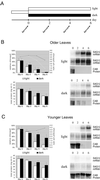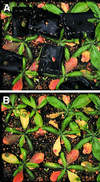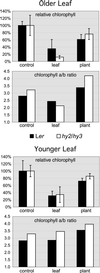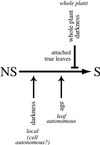Senescence is induced in individually darkened Arabidopsis leaves, but inhibited in whole darkened plants
- PMID: 11706170
- PMCID: PMC129259
Senescence is induced in individually darkened Arabidopsis leaves, but inhibited in whole darkened plants
Abstract
It has long been known that leaf senescence can be induced in many plant species by detaching leaves and placing them in the darkness. It recently has been shown that entire Arabidopsis plants placed in the darkness are not induced to senesce, as judged by visible yellowing and certain molecular markers. Here, we show that when individual Arabidopsis leaves are darkened, but not when entire plants are darkened, senescence is induced in the covered leaves. This induction of senescence is highly localized. The phenomenon is leaf age dependent in that it occurs more rapidly and strongly in older leaves than in younger ones, as is the case with many forms of induced senescence. Whole adult plants placed in darkness, in contrast, show delayed senescence, although seedlings lacking primary leaves do not. These observations imply that the light status of the entire plant affects the senescence of individual leaves. A model summarizing the results is presented.
Figures






Similar articles
-
Major Cys protease activities are not essential for senescence in individually darkened Arabidopsis leaves.BMC Plant Biol. 2017 Jan 6;17(1):4. doi: 10.1186/s12870-016-0955-5. BMC Plant Biol. 2017. PMID: 28061816 Free PMC article.
-
The impact of light intensity on shade-induced leaf senescence.Plant Cell Environ. 2012 Jun;35(6):1084-98. doi: 10.1111/j.1365-3040.2011.02474.x. Epub 2012 Jan 6. Plant Cell Environ. 2012. PMID: 22171633
-
Strigolactone Regulates Leaf Senescence in Concert with Ethylene in Arabidopsis.Plant Physiol. 2015 Sep;169(1):138-47. doi: 10.1104/pp.15.00325. Epub 2015 May 15. Plant Physiol. 2015. PMID: 25979917 Free PMC article.
-
Leaf senescence.Annu Rev Plant Biol. 2007;58:115-36. doi: 10.1146/annurev.arplant.57.032905.105316. Annu Rev Plant Biol. 2007. PMID: 17177638 Review.
-
Dark-induced leaf senescence: new insights into a complex light-dependent regulatory pathway.New Phytol. 2016 Nov;212(3):563-570. doi: 10.1111/nph.14217. Epub 2016 Sep 26. New Phytol. 2016. PMID: 27716940 Review.
Cited by
-
Perception of Arabidopsis AtPep peptides, but not bacterial elicitors, accelerates starvation-induced senescence.Front Plant Sci. 2015 Jan 23;6:14. doi: 10.3389/fpls.2015.00014. eCollection 2015. Front Plant Sci. 2015. PMID: 25667591 Free PMC article.
-
Compartment-specific investigations of antioxidants and hydrogen peroxide in leaves of Arabidopsis thaliana during dark-induced senescence.Acta Physiol Plant. 2016;38:133. doi: 10.1007/s11738-016-2150-6. Epub 2016 May 6. Acta Physiol Plant. 2016. PMID: 27217598 Free PMC article.
-
Physiological and proteome studies of maize (Zea mays L.) in response to leaf removal under high plant density.BMC Plant Biol. 2018 Dec 29;18(1):378. doi: 10.1186/s12870-018-1607-8. BMC Plant Biol. 2018. PMID: 30594144 Free PMC article.
-
Species-specific variation in the importance of the spectral quality gradient in canopies as a signal for photosynthetic resource partitioning.Ann Bot. 2004 Nov;94(5):725-32. doi: 10.1093/aob/mch197. Epub 2004 Sep 16. Ann Bot. 2004. PMID: 15374835 Free PMC article.
-
Differential impact of lipoxygenase 2 and jasmonates on natural and stress-induced senescence in Arabidopsis.Plant Physiol. 2010 Apr;152(4):1940-50. doi: 10.1104/pp.110.153114. Epub 2010 Feb 26. Plant Physiol. 2010. PMID: 20190093 Free PMC article.
References
-
- Biswal UC, Biswal B. Photocontrol of leaf senescence. Photochem Photobiol. 1984;39:875–879.
-
- Biswal B, Choudhury NK. Photocontrol of chlorophyll loss in papaya leaf discs. Plant Cell Physiol. 1986;27:1439–1444.
-
- Biswal B, Choudhury NK, Sahu P, Biswal UC. Senescence of detached fern leaves. Plant Cell Physiol. 1983;24:1203–1208.
-
- Biswal UC, Kasemir H, Mohr H. Phytochrome control of degreening of attached cotyledons and primary leaves of mustard (Sinapis alba L.) seedlings. Photochem Photobiol. 1982;35:237–241.
Publication types
MeSH terms
Substances
Grants and funding
LinkOut - more resources
Full Text Sources
Other Literature Sources
